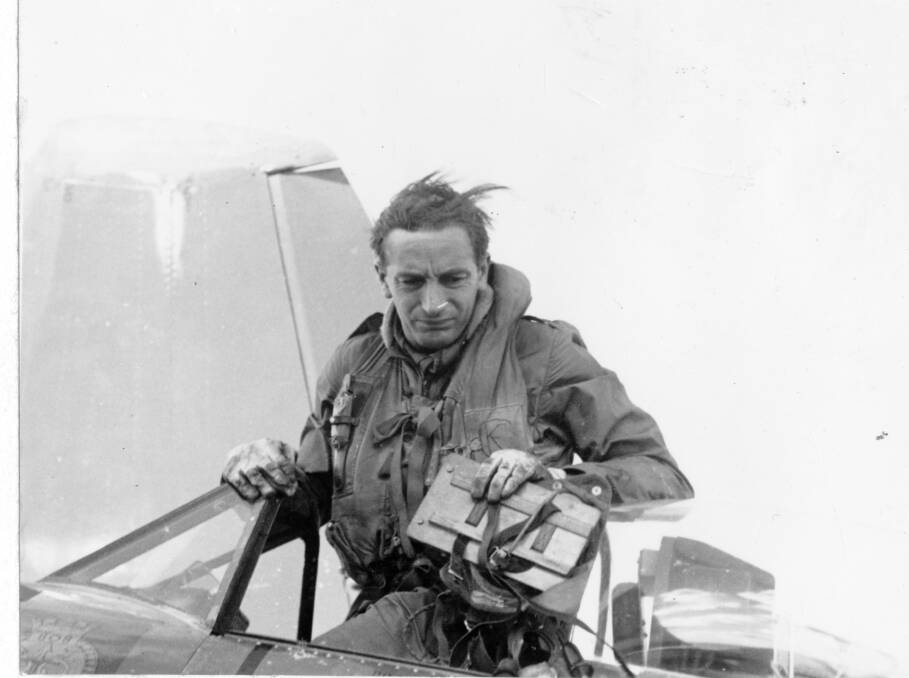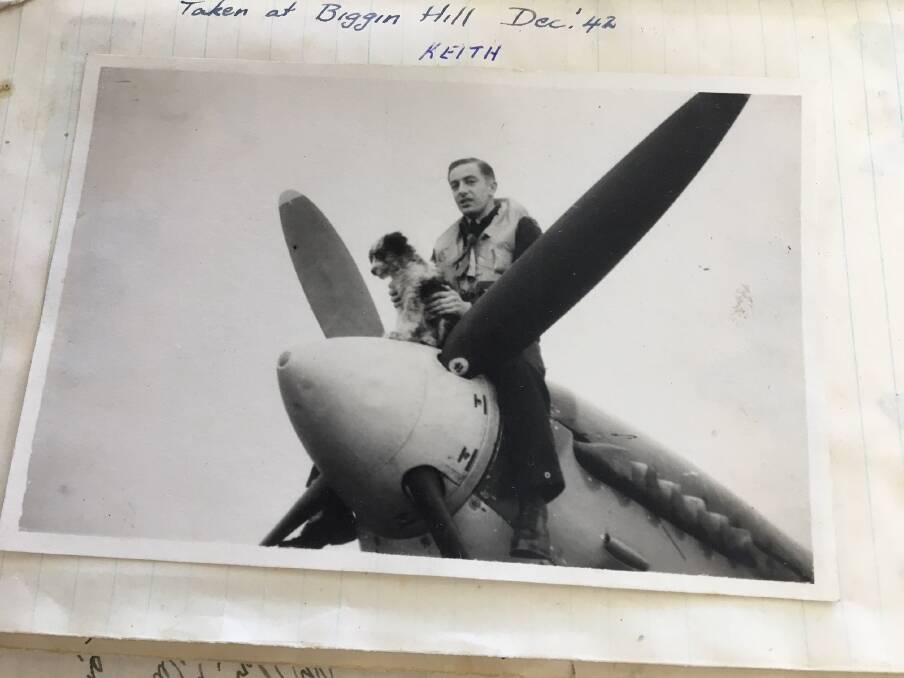The descendants of an Australian war veteran who served valiantly in WWII and was killed in battle over North Korea in 1951 donated his medals, including the Distinguished Flying Medal, to the Fleet Air Arm Museum at Nowra Hill on Tuesday.
Subscribe now for unlimited access.
$0/
(min cost $0)
or signup to continue reading
The navy honoured the late Spitfire pilot LEUT Keith Clarkson and thanked his family for their generosity with a Spitfire flyover at HMAS Albatross on Tuesday.
About 100 people including six of the RAAF and RAN veteran’s family members, stood on the tarmac following the Spitfire’s every manoeuvre in awe of the operational WWII relic.
Before the flyover, in a room filled with influential navy, airforce and museum representatives, Kenny Best, the nephew of Keith Clarkson’s sister June Best, read a stirring diary entry penned by the Australian pilot during World War II in April 7, 1943.
The diary entry detailed LEUT Clarkson’s lucky escape when his Spitfire was gunned down over Tunisia on April 2, 1943 (scroll down to read the full diary entry).
Mr Best struggled to contain the emotion in his voice and finished the reading with a question.
“What were Keith’s thoughts in the minutes before he so valiantly gave up his life in Korea after experiencing going down and having to bail out of his plane during WWII in North Africa?” he said.
HMAS Albatross Chief Staff Officer Captain Darren Rae was moved by the harrowing account of the veteran’s experience in WWII.
“Keith Clarkson was a true hero,” captain Rae said.
“We talk about heroes and bravery, we hear those over-used phrases every weekend at the football. That’s not bravery.
“We couldn’t be prouder of your ancestor. He was dedicated, educated, articulate, ready to go, fit. The legacy he leaves here is incredible.”

LEUT Clarkson survived the war, and transferred from the RAAF to the RAN.
He was serving as a senior pilot in the navy’s 805 Squadron when his plane was shot down over North Korea on November, 5, 1951.
LEUT Clarkson’s body has never been recovered.
His family laments that his sister, June, who died last year at the age of 92, was never able to bury him.
Living relatives hope communications between the Australian government and North Korea improve, so they can have closure.

Keith Clarkson’s diary entry
April 7, 1943
Up to the second of April we were not very active but then we got some good weather and did a lot of flying. On the third of April we took a bunch of Mitchells over to bomb a drome. We were flying in two lots of six; I was yellow two in the commanding officer’s section Flight Lieutenant Cox being my Number One. On the way back, Cox and I saw two ME109’s below so the two of us peeled off and went after them. The right hand one broke away and started climbing and we followed him up. Cox fired at him, but missed, and then I fired a short burst at about 250 yards with 10-20 deflection. I saw an explosion in front of his tailplane but had to leave off, as Cox went down in a hell of a dive to 10,000 foot. We climbed back to about 13,000 foot and saw two or three 109’s kicking about. We were all by ourselves and the rest of the squadron had lost us and our position was about 15 miles southwest of Medjez-el-Bab (Tunisia).
We had finished climbing and all of a sudden, I felt several terrific thuds, something hitting my leg and hand and the cockpit filled with smoke. The ailerons were jammed as all I could do was skid and jerk violently. He had another burst at the engine and then scrammed. It was one of the ME 109’s. In the first burst he blew quite a bit of my port aileron away and jammed my controls, blew most of the hood off, put a cannon shell just down by the side of the seat, and another bullet hit the throttle quadrant, busting it up. In the second burst he hit my pitch mechanism and put a couple of holes in the prop. After the second attack the prop went into fully coarse and within a few seconds the engine packed up. Fortunately I was at a good height and was able to glide for a few miles over our lines. I decided to bail out as it is very rugged country and no places for a forced landing. I glided down to 7-8000 feet, undid my harness, took off my helmet, trimmed it to fly as near to straight and level as it would and started crawling over the side. I got halfway out when it went into a nosedive practically straight down. My left leg was stuck in the cockpit and I couldn’t get it out, so I grabbed hold of the trailing edge of the wing and pulled like the devil and after what seemed like eternity my leg came out and I went whizzing through the air, spinning like a top. I jerked the ripcord and the chute opened and there I was about 800ft up, so I must have got out of the plane at about 1000ft. Lucky me. Just as the chute opened I heard an explosion and the plane had hit the ground and was burning fiercely. I was coming down into a deep valley and the wind was blowing me backwards against the side of the hill so I had to turn the chute around, I touched down very lightly in my stockinged feet and released the harness. As I didn’t know exactly where I was, I thought I’d better walk as far west as possible as there may have been some Jerries about, but some Arabs came along and they were friendly. They said in French that the British army was just over the hill and one of them gave me his sandals to walk in.
A couple of them carried the chute and in short time, three RAMC officers came along. I got to the top of the hill and from there rode about three miles to Thilbar where the RAMC are stationed in the monastery.
They operated on my leg to remove splinters and cleaned up my hand and I slept there the night. In the morning Mr Cox came up in the jeep and I went back to the drome.


